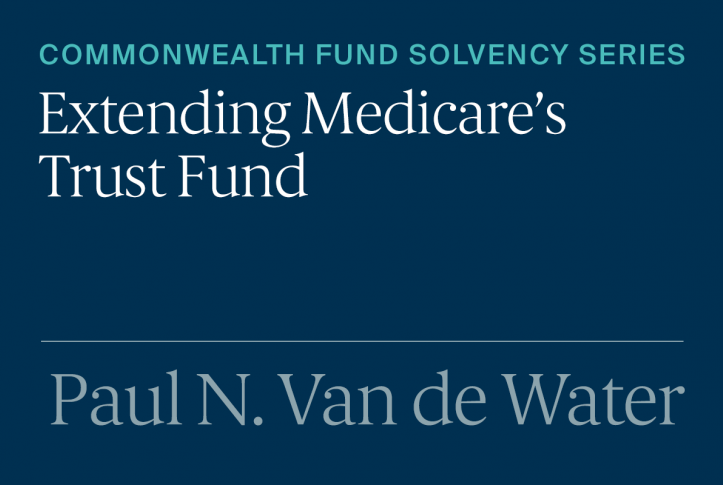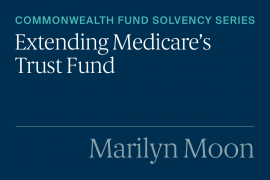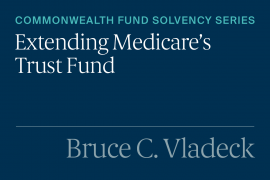The Medicare Hospital Insurance (HI) Trust Fund, which pays for Medicare beneficiaries’ hospital bills and other services, is projected to become insolvent in 2031. Without changes to expected spending or trust fund revenue, the trust fund will not have sufficient funds to cover the entire cost of beneficiaries’ health care. The HI trust fund is primarily funded through payroll taxes paid by employers and employees, with some additional income from interest as well as premiums paid by voluntary enrollees not automatically entitled to Medicare Part A. Will the trust fund solvency be extended by reducing the projected growth in expenditures, raising revenues, changes to the services covered by Medicare Part A, or a combination of these options
To stimulate policy discussions, the Commonwealth Fund asked a group of Medicare thought leaders with a variety of backgrounds and political affiliations to outline how they would extend the life of the trust fund. This series presents their perspectives, highlighting areas of commonality while also putting forth some new ideas for addressing this pressing issue.
Phasing in large Medicare spending cuts in time to avoid depletion of the Hospital Insurance Trust Fund is not feasible — or desirable. With the nation still likely to be recovering from the pandemic and recession, raising payroll taxes in the near term would also be inopportune. And allowing the trust fund to borrow would just dig the financing hole deeper. General revenues should therefore be part of the immediate solution for strengthening Medicare financing, along with some of the other policies recommended below.
Dedicating the Medicare Tax on Unearned Income to the HI Trust Fund. One logical form of general revenue financing would be to dedicate the proceeds of the net investment income tax (NIIT) to the HI trust fund. In the Health Care and Education Reconciliation Act of 2010, Congress enacted a 3.8 percent tax on the net investment income of high-income taxpayers that was termed the “unearned income Medicare contribution.” Because of procedural limitations on the congressional reconciliation process, however, the proceeds of this tax could not be dedicated to the HI trust fund and instead go to the general fund. As a first step toward restoring solvency, policymakers should rectify this omission.
Under this proposal, future proceeds from the NIIT would be deposited in the HI trust fund, amounting to approximately $350 billion over the 2021–2030 period and closing a little less than half of the 10-year HI shortfall as estimated by the Congressional Budget Office (CBO). In addition, the general fund would transfer to the trust fund an amount equal to the present value of the past proceeds of the tax, or more than $200 billion. Since these actions would reallocate the revenue from an existing tax but not raise new revenue, they would improve the status of the HI trust fund but not reduce the overall federal deficit.
Shifting Spending Out of the HI Trust Fund. An indirect way of using general revenues to strengthen Medicare would be to remove some category of spending from the HI trust fund and replace it with a new program financed by general revenues. The Trump administration’s 2021 budget proposed just such a shift for spending on graduate medical education, while reducing spending on medical education. The Obama administration proposed smaller reductions in spending on medical education. The Trump administration proposal would reduce Medicare spending by $168 billion over the 2021–2030 period, according to CBO estimates.
Filling the Gaps Between the Net Investment Income Tax and the Medicare Self-Employment Tax. In addition to the NIIT, high-income taxpayers pay a 3.8 percent Medicare employment tax on earnings and self-employment income over $200,000 for single taxpayers and $250,000 for couples. But some income from professional services — such as distributions received by active S-corporation shareholders — is not subject to either tax, which creates significant opportunities for tax avoidance. The Obama administration’s 2017 budget proposed eliminating these gaps. This proposal would have raised $236 billion in new revenue over the 2017–2026 period, according to the Joint Committee on Taxation.
Reducing Provider Payments. Although reductions in excessive provider payments would not on their own be enough to avert trust fund depletion, they could help improve solvency in the medium term. For example, the Medicare Payment Advisory Commission (MedPAC) and both the Obama and Trump administrations have proposed scaling back payments to postacute care providers — including skilled nursing facilities, inpatient rehabilitation facilities, and home health agencies — which are too high relative to the cost of care. The proposal in the 2021 budget would save Medicare $79 billion over 10 years, according to the CBO.
Some other proposals from MedPAC and the Trump administration’s fiscal year 2021 budget, such as site-neutral payments to equalize Medicare’s payments to different kinds of facilities, also deserve serious consideration. The budgetary savings, in that case, would accrue primarily to Medicare’s Supplementary Medical Insurance Trust Fund.
Reducing Overpayments to Medicare Advantage Plans. Currently, nearly two-thirds of beneficiaries opt for traditional Medicare, while more than one-third are enrolled in private Medicare Advantage (MA) plans. Reducing overpayments to MA plans can help improve HI solvency.
Medicare Advantage plans have considerable latitude in designing their benefit packages and can use supplemental benefits, such as fitness benefits, to attract healthier or other more profitable enrollees. Medicare’s payment system attempts to correct for differences in the health status of plans’ enrollees through risk adjustment. Nonetheless, MedPAC estimates that MA plans are overpaid by about 2 percent to 3 percent compared to traditional Medicare because of the way they code their enrollees’ health conditions, generating about $6 billion a year in additional payments to MA plans.
Some evidence indicates that the overpayment amounts may be even greater. For example, the Kaiser Family Foundation found that people who switched from traditional Medicare to MA had $1,253 (or 13%) less Medicare spending, on average, in the year before switching than beneficiaries who remained in traditional Medicare, even after risk adjustment. Richard Kronick of the University of California, San Diego, estimates that Medicare will overpay MA plans by about $200 billion over the next decade.
Increasing the Medicare Payroll Tax Rate. The HI program is financed primarily by a payroll tax contribution of 2.9 percent, divided equally between employers and employees. High-income taxpayers pay an additional Medicare contribution of 0.9 percent on earnings above $200,000 for singles and $250,000 for couples, for a total tax of 3.8 percent. Although raising the tax rate would not be timely while the economy is recovering from the recession, policymakers should consider phasing in an increase in the Medicare payroll tax as the economy approaches full employment. At the same time, they should keep in mind that Social Security also faces depletion of its trust fund in the next decade and also may need additional payroll tax financing.
The long-run HI shortfall amounts to 0.76 percent of taxable payroll, according to Medicare’s trustees. That means that a payroll tax increase of 0.38 percent each on employers and employees would completely close the program’s long-run deficit. A smaller increase could be combined with some of the other proposals suggested here to help close the imbalance or create room for benefit improvements.
Financing Benefit Improvements. The Medicare benefit package is not overly generous, and benefit reductions are unlikely to make a significant contribution to improving HI solvency. To the contrary, several improvements in Medicare benefits are under consideration and would need to be paid for.
Placing a cap on total annual out-of-pocket spending by Medicare beneficiaries — a vital benefit that MA plans offer but traditional Medicare lacks — belongs at the top of the list. In addition, as a candidate President Joe Biden proposed lowering the age of eligibility for Medicare to 60. Rep. Frank Pallone, chair of the House Committee on Energy and Commerce, has released a draft proposal to create a new Medicare long-term care benefit. And the House has passed legislation that would use savings from prescription drug legislation to pay for dental, hearing, and vision benefits and improved premium and cost-sharing assistance for low-income beneficiaries. Benefit improvements like these would require new financing above and beyond what is needed to restore Medicare solvency.



